By Joe Gresh
After riding through the stifling heat of Utah, Nevada and central California the cold, foggy mists of the Monterey Peninsula penetrated my mesh jacket and I shivered. It was wonderful to be cold and it was wonderful to be at Laguna Seca’s Weather Tech Raceway. This wasn’t my first visit to Laguna Seca but it was my first time inside the track. Years ago I rode up from San Diego back when Laguna Seca was a date on the world championship calendar. Today, Austin’s COTA circuit has usurped that role in America but Laguna Seca is still way prettier.
Two strokes ruled Moto GP racing in that era and when I pulled up to the entrance gate the $50 ticket price almost gave me a stroke. I was earning $3.50 an hour working on boats and $50 was a ton of money. I figured the hell with it and went to the Monterey Bay Aquarium instead. Oddly enough, the entry fee for AHRMA’s Motofest vintage racing was still 50 dollars some 40 years on. This time I paid for a ticket because riding from La Luz, New Mexico is a long way to go for nothing.
Motels around Monterey are sort of expensive. Your best deal is the 4-day camping pass at the track. I bought a reserved campsite because I wasn’t sure how things worked inside. Turns out there were plenty of campsites available for this event. I had site 110A, which gave me a view of turn 5 in one direction and a view of the bikes going up Rahal hill to the Corkscrew in the other direction.
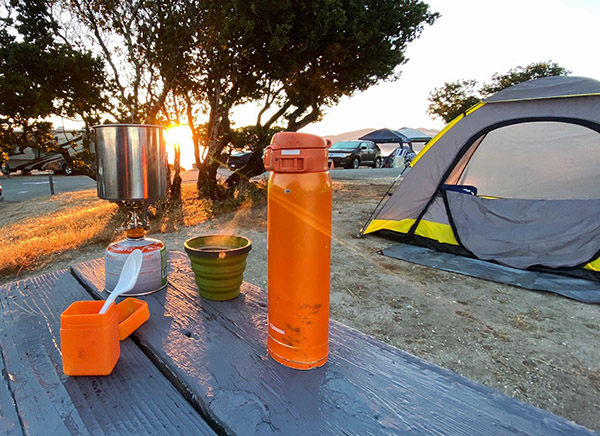
Plenty of portable toilets were sprinkled around the venue and hot showers were available in the more substantial structures. All the faucets were marked non-potable so bring plenty of water. I had to buy those little bottled waters in the paddock at $3 a bottle. The ground at my site was pretty hard so I never got my flimsy aluminum tent pegs to penetrate. Luckily my site had an old steel spike that someone left behind. I drove the spike into the hard ground on the windward side, tied the tent to the spike and used my gear to hold the other three corners down. The hydraulic jack came in handy as a hammer.
I say the ground was hard but apparently the hundreds of ground squirrels had no problem burrowing holes every 15 feet. The squirrels are all over the place at Weather Tech. I’m surprised that an aged vintage motorcycle racer hasn’t fallen in a squirrel hole and broken a leg. I’ve heard that when they get up in years it’s best to shoot them rather than let them suffer.
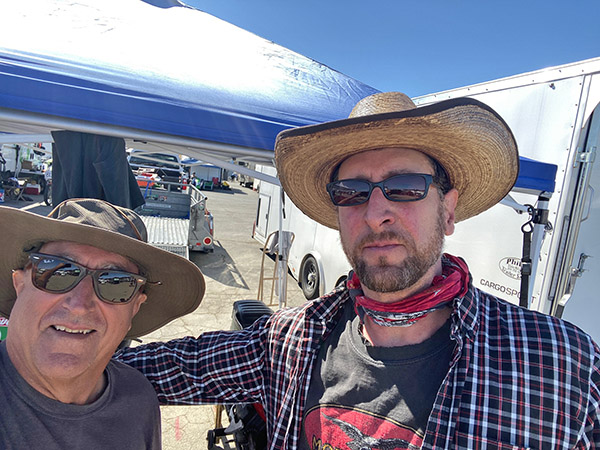

Thursday was practice all day. The bikes were sent out in groups with staggered starts. There are a lot of classes in AHRMA, like dozens, to keep track of but I mostly just listened for two-strokes. AHRMA’s Motofest had a sort of mini Motorcyclist magazine reunion vibe. The Kevin Hipp racing family was there along with Thad Wolff and Ed Milich. Go-Go Gulbransen, whose name the announcer never tired of uttering was there also. Go-Go was the guy who tested the upper limits of new sport bikes for Motorcyclist magazine. All these guys live and breathe motorcycles and it’s the passion you can’t fake that made them such good journalists.
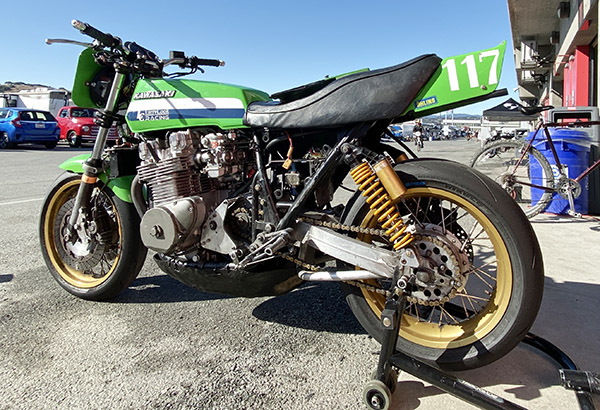
Vintage racing today looks a bit different from when the motorcycles were current models. Hondas seem to dominate. The 160cc slopers, 175 twins and 350 twins were much faster than I remember them. In fact, I don’t remember them racing at all. I assume it’s due to better oils and electronic ignition systems, because in the old days the small bore grids were mostly Yamahas with a few Suzukis and Kawasakis. If there was a Honda racing it was usually sputtering at the tail end of the pack and the rider was wearing construction boots and welding leathers. Of course, things were different at the GP/factory level where Honda did all right for itself considering the handicap it was working under. It helps to have Mike Hailwood and Freddie Spenser on your team.

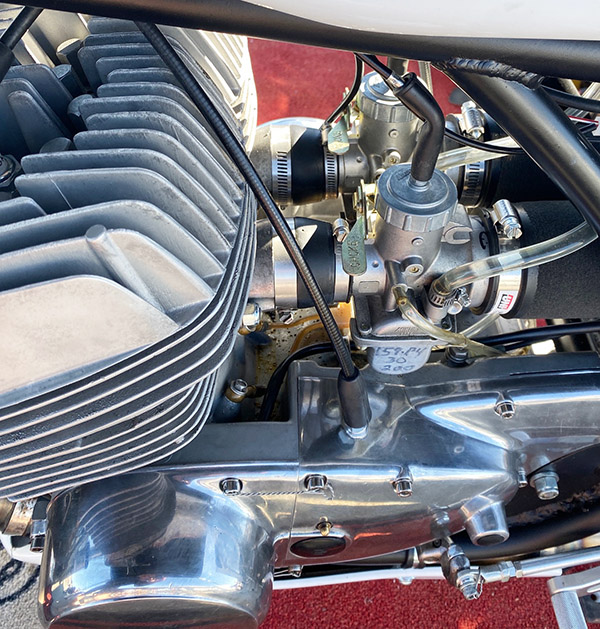
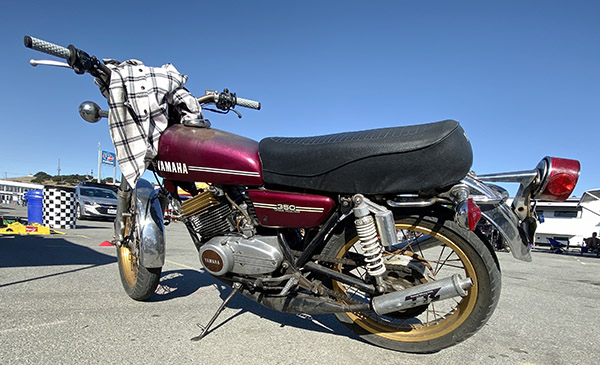
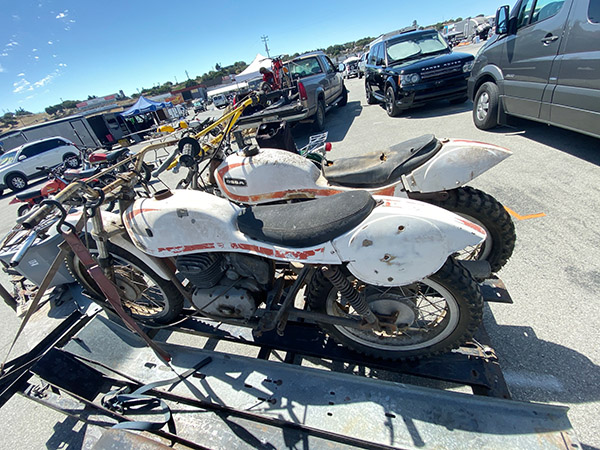


After setting up camp I walked all over Laguna Seca: I needed the exercise after sitting on the ZRX1100 for five long days. To get to Monterey I took the long way around, up through Colorado to Grand Junction then across Utah and Nevada to California. I tried to ride Highway 120 through Yosemite Park but the road was closed. I detoured north from Lee Vining to Highway 108 and was rewarded with one of the world’s great motorcycle roads. Anyway, from my campsite to the paddock was only a 15-minute walk. Less if you didn’t tangle with a ground squirrel.
Vintage racing is all about the paddock. The racing, while serious, is almost secondary to checking out the old race bikes. The paddock is where the food is, where the beer is and where the old motorcycles are. Most of the spectators hang out in the paddock area. I wandered around for hours looking at motorcycles. I ate a turkey sandwich and drank a beer that was like 28 dollars but we need to support the moneymaking aspect of Laguna Seca or it’ll become luxury housing.
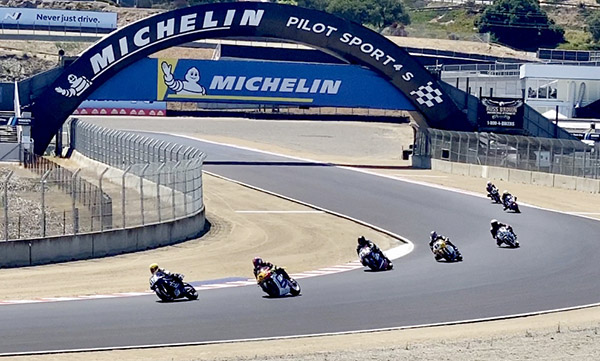

Saturday and Sunday were race days. I hung out with Motorcyclist Magazine alumni Ed Milich for a bit. Ed has an admirable cost per win philosophy in that he expends just enough effort to get first place and no more. His bikes look like hell but they run great. Paint don’t win races, says Ed. On the track he never seems to be trying hard, the gap between him and second place grew larger as if by magic. Ed won every race he entered (four) I did some math and determined that Ed spends around $4.37 per win. Hipp won his races also. Hipp’s bikes are those fast Honda 350s and they look like show bikes. Hipp’s wins probably cost more than Milich’s, but they still count.
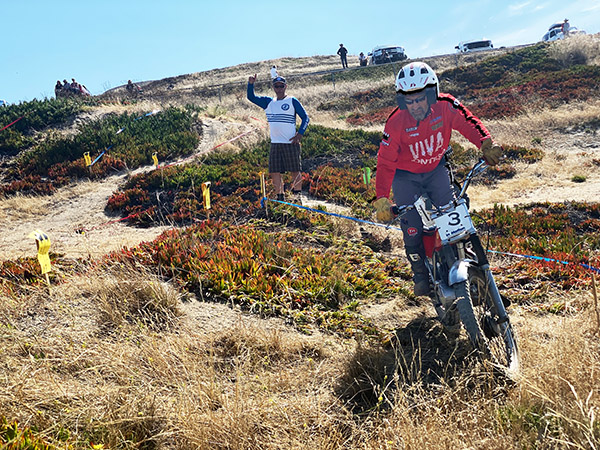
Sunday morning I went over to the trials section. Set in gullies and on the sides of hills, trials riding never looks too hard until you try it. Trials events at the level Laguna Seca puts on have the advantage of being relatively safe as the speeds are very low and you can’t fall very far. This isn’t the crazy stadium trials you watch on YouTube but it suits the old motorcycles participating. I might try the trials on Godzilla next time I go to Laguna.
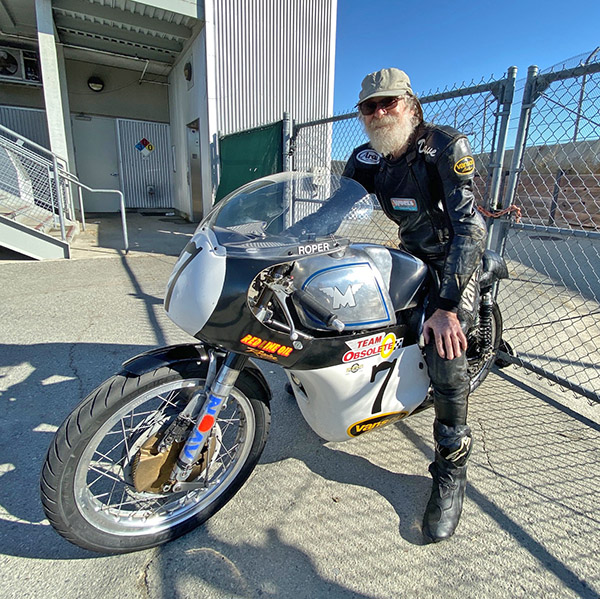
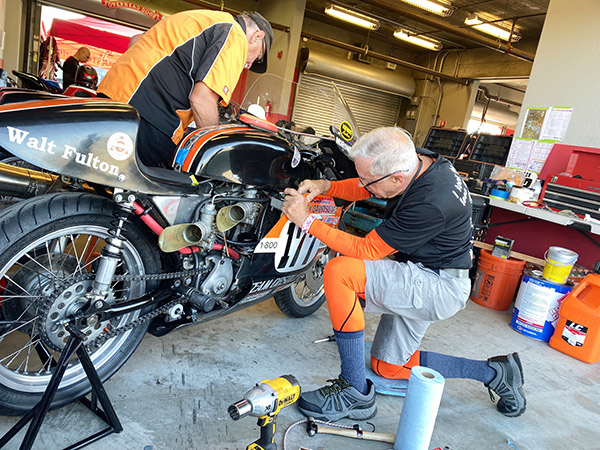
With such wildly different motorcycles it’s hard to compare rider skill. Except when it comes to Dave Roper: Roper, who resembles a stick of beef jerky with a cotton ball stuck on one end, was smooth and fast on any bike he rode. Roper and Walt Fulton, with a combined 300 years of racing experience, put on quite a show with their matching H-D branded, Aermacchi Sprints. There was a vintage motocross at Laguna Seca but it ran concurrent with some other races so I missed it. You really need to be two people to see all the action at AHRMA’s Vintage Motofest.
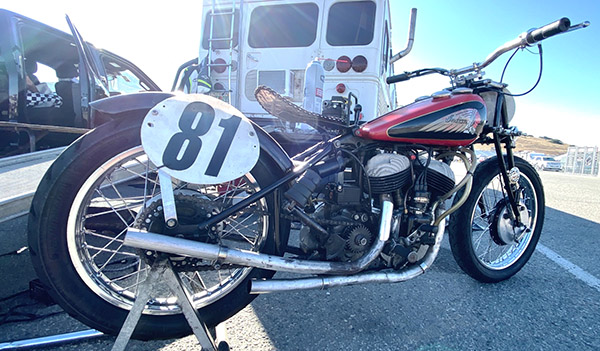
It was nice to have the campsite for Sunday night; I didn’t have to rush to pack and head out into the unforgiving freeways of California in the late afternoon. Wherever I ride the ZRX1100 it attracts attention. I’ve had people take selfie photographs standing next to the bike, I get asked what year it is almost every ride. The thing is bone stock. Laguna Seca was no different, the bike garnered a steady stream of complements from my camp neighbors. I must look hard up because the guy camping across from me handed me 40 dollars and said I had dropped it. I think he was trying to be nice to a vagabond. Normally I would have taken it but I’m trying to become a better person and told the guy it wasn’t mine.
Californians and Ex-Californians like to bitch about their state, but the damn place is beautiful. California has it all from the beaches to the mountains to the desert and all types of terrain in between. With straight roads crowded by farm equipment, the central valley (also known as The Breadbasket of America) was like the Tail of the Dragon for my nose. Sweet manure, grassy hay, dust and soil, the smells kept swapping back and forth giving my nasal passages whiplash. If it wasn’t so expensive, I’d live in California again but my total running costs at Tinfiny Ranch are less than the annual taxes on any house I could afford there. The Californians I met were universally friendly and interesting to talk to, we would start up a conversation like we had known each other for years and had just spoken last Thursday.
I’ll go to AHRMA’s Monterey bash again. It’s closer than Daytona for me and with the camping, about the same cost. I give the event high marks for value. You really get your 50 dollars worth with AHRMA.
Never miss an ExNotes blog:
Want the story on the ZRX resurrextion? It’s right here.

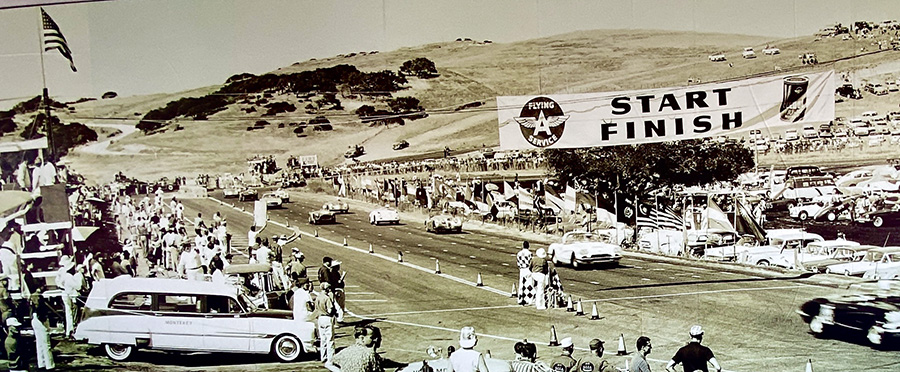
 Motorcycle road racing in America has not met expectations for quite a while now. Our guys are no longer dominating GP racing as they did in decades past. MotoAmerica, our premier road racing league has made strides by reinstalling the 1000cc bikes as the premier class and bumping the 600’s down to B-team. Hiring my Internet-buddy Andrew Capone as rainmaker for the series is another great move towards professional sponsorship and revenue generation. I’ve never raced on pavement but I rank as an expert spectator due to the sheer number of road races I’ve attended. I’ve got a few ideas on how to make MotoAmerica better and I’m not shy about cranking them out.
Motorcycle road racing in America has not met expectations for quite a while now. Our guys are no longer dominating GP racing as they did in decades past. MotoAmerica, our premier road racing league has made strides by reinstalling the 1000cc bikes as the premier class and bumping the 600’s down to B-team. Hiring my Internet-buddy Andrew Capone as rainmaker for the series is another great move towards professional sponsorship and revenue generation. I’ve never raced on pavement but I rank as an expert spectator due to the sheer number of road races I’ve attended. I’ve got a few ideas on how to make MotoAmerica better and I’m not shy about cranking them out. American road racers are never going to get back atop the pinnacle of GP racing until they test themselves against the world’s best. It’s expensive for a US rider to got to Europe so why not bring Europe to the USA? What if all the contract issues could be solved and MotoAmerica paid start money to a few of the GP guys? Pay Rossi to start a few races, Marquez or Dovizioso would be a huge draw. I’m guessing the increased gate alone would pay for Rossi. This harkens back to when European motocross stars were paid to compete over here. American racers gained first hand experience on where they needed to be in order to defeat the best. There is no physical barrier preventing our top AMA racers from competing on even terms with world-class GP racers. Show our greyhounds the European rabbit and they will move heaven and earth to stay on their tail.
American road racers are never going to get back atop the pinnacle of GP racing until they test themselves against the world’s best. It’s expensive for a US rider to got to Europe so why not bring Europe to the USA? What if all the contract issues could be solved and MotoAmerica paid start money to a few of the GP guys? Pay Rossi to start a few races, Marquez or Dovizioso would be a huge draw. I’m guessing the increased gate alone would pay for Rossi. This harkens back to when European motocross stars were paid to compete over here. American racers gained first hand experience on where they needed to be in order to defeat the best. There is no physical barrier preventing our top AMA racers from competing on even terms with world-class GP racers. Show our greyhounds the European rabbit and they will move heaven and earth to stay on their tail.